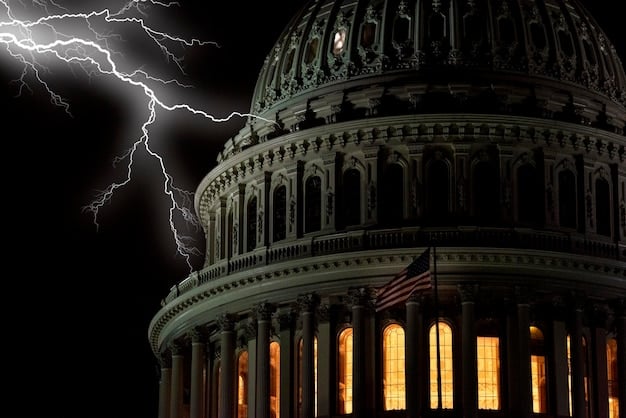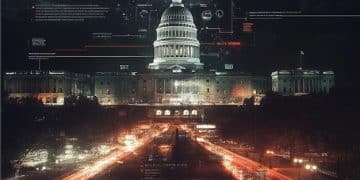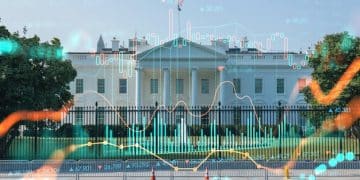Will New Budget Proposal Trigger a 2025 Government Shutdown?

The prospect of a government shutdown in early 2025 due to a new congressional budget proposal hinges on complex political negotiations, differing party priorities, and the ability of lawmakers to find common ground amidst fiscal pressures and a divided legislative landscape.
The intricate dance of federal budgeting often culminates in high-stakes drama, leaving many to wonder: Will the New Congressional Budget Proposal Trigger a Government Shutdown in Early 2025? As the legislative calendar progresses, the looming expiration of current funding mechanisms and the introduction of new budgetary blueprints invariably ignite intense debate. Understanding the complex interplay of political will, fiscal realities, and partisan divides is crucial to forecasting the stability of government operations.
understanding the congressional budget process
The U.S. congressional budget process is a multi-stage, often convoluted procedure designed to allocate federal funds and authorize government spending. It begins with the President’s budget request, typically submitted in early February, outlining the administration’s priorities and proposed spending levels for the upcoming fiscal year, which starts on October 1st.
However, this request is merely a starting point. Congress holds the “power of the purse,” meaning it has the ultimate authority to determine how federal money is spent. This power is exercised through the passage of various appropriations bills, which are critical for funding government agencies and programs. The process is lengthy, involving multiple committees and requiring significant negotiation between the House of Representatives and the Senate.
key stages of budget formulation
Several key stages define the budget process, each presenting potential choke points for legislative agreement. The first major hurdle is often the passage of a budget resolution, a non-binding framework that sets overall spending limits and revenue targets. While not law, it guides the appropriations committees in drafting the actual spending bills.
- President’s Budget Request: Outlines executive branch spending priorities.
- Budget Resolution: Sets overall spending caps and revenue goals for Congress.
- Appropriations Bills: Specific legislation that funds federal agencies and programs.
Following the budget resolution, Congress then moves to pass 12 individual appropriations bills, each funding different parts of the government. This decentralized approach often complicates matters, as each bill can become a battleground for specific policy Riders or spending priorities. If even one of these bills is not passed by the October 1st deadline, or if a continuing resolution (CR) is not enacted, parts of the government can face a shutdown.
The intricate nature of this process, coupled with the inherent political differences, means that deadlines are frequently missed. When this occurs, Congress often resorts to passing continuing resolutions to temporarily fund the government at existing levels, thereby averting a shutdown. These CRs, however, are short-term fixes and do not address the fundamental disagreements over long-term spending priorities.
The expiration of a large number of these temporary funding measures, particularly if they extend close to the end of the fiscal year or beyond, can create a cumulative pressure point. This pressure is amplified when a new budget proposal, especially one with significant changes, enters the arena, setting the stage for potential conflict and, in severe cases, a government shutdown.
the anatomy of a government shutdown
A government shutdown occurs when Congress fails to pass legislation funding government agencies and programs for the upcoming fiscal year, or when it fails to pass a continuing resolution. This doesn’t mean the entire government ceases to function. Essential services and personnel, such as those related to national security, public safety, and critical health functions, are generally deemed “essential” and continue to operate, often without pay initially. However, many non-essential government operations cease, leading to furloughs for hundreds of thousands of federal employees and disruptions to various public services.
impacts and consequences
The immediate impacts of a shutdown are often visible: national parks close, passport processing slows, and many government websites go dark. The economic consequences can range from minor disruptions to significant setbacks, depending on the duration and scope of the shutdown. Small businesses that rely on government contracts may face delays in payments, and consumer confidence can waver.
- Economic Disruption: Reduced government spending, delayed contracts, and diminished consumer confidence.
- Workforce Furloughs: Hundreds of thousands of federal employees temporarily out of work or working without immediate pay.
- Service Interruptions: Delays in passport renewals, research grants, and certain regulatory functions.
Beyond the immediate effects, prolonged shutdowns can have lasting consequences, eroding public trust in government’s ability to govern effectively. They can also impact global perceptions of U.S. stability, potentially affecting financial markets and international relations. The uncertainty created by shutdown threats can also make it difficult for agencies to plan and execute long-term projects, affecting everything from infrastructure development to scientific research.
Historically, shutdowns have often been triggered by fundamental disagreements over spending levels, specific policy provisions attached to appropriations bills, or broader fiscal policy debates. The brinkmanship involved in these negotiations means that both parties attempt to use the threat of a shutdown as leverage to achieve their legislative goals. This often pushes the process to the very last minute, increasing the likelihood of an actual lapse in funding if a compromise cannot be reached.
Understanding the “anatomy” of a shutdown involves recognizing that it is not a sudden, unpredictable event, but rather the culmination of a protracted legislative stalemate. It represents a failure of political will and compromise, with consequences that ripple through the government, the economy, and the lives of ordinary citizens.
the new congressional budget proposal: what’s in it?
The specifics of the new congressional budget proposal for early 2025 are central to predicting a potential shutdown. While exact details will evolve, such proposals typically outline significant shifts in federal spending priorities, revenue projections, and potential policy changes. These can range from modest adjustments to ambitious overhauls, aiming to address critical national issues or reflect the prevailing ideological leanings of the majority party.
key areas of proposed change
New budget proposals often focus on several key areas, reflecting the economic and social challenges of the time. These might include substantial increases or cuts to defense spending, adjustments to social programs like Medicare and Social Security, or new investments in areas such as infrastructure, climate change initiatives, or technological research. Each proposed change becomes a potential point of contention.
- Defense Spending: Proposed increases or decreases can reflect evolving geopolitical landscapes or domestic priorities.
- Social Programs: Adjustments to entitlements often spark heated debate due to their widespread impact.
- Economic Development: Investments in infrastructure, clean energy, or job training programs indicate forward-looking policies.
Beyond broad category spending, proposals frequently contain specific policy riders – provisions attached to spending bills that aim to enact non-budgetary policy changes. These riders, often championed by particular factions or interests, can be highly controversial and serve as deal-breakers for opposing parties. For example, a rider restricting certain agency actions or promoting specific social policies could easily derail an appropriations bill, even if the overall funding levels are agreeable.
The revenue side of the budget equation is equally critical. A new proposal might suggest tax cuts, tax increases, or reforms to the tax code, all of which have profound economic and political implications. Debates over how much revenue the government should collect, and from whom, are often among the most intractable in budget negotiations, reflecting fundamental differences in economic philosophy.
The budget’s proposed deficit and debt trajectory also warrant close scrutiny. If the new proposal projects a significantly larger deficit or acceleration of national debt, it is likely to face opposition from fiscal conservatives across the aisle, escalating the risk of a standoff. Therefore, the “what’s in it” of the budget proposal is not just about numbers, but also about the underlying policy implications and the political will to enact them.
political landscape and partisan divides
The political landscape in early 2025 – specifically, which party controls the House, Senate, and White House – will profoundly influence the likelihood of a government shutdown. A divided government, where different parties control branches or chambers, inherently increases the risk of gridlock. In such scenarios, compromise becomes a necessity, but also a challenge, as each party seeks to uphold its core principles and appease its base.
areas of probable contention
Partisan divides typically center around fundamental disagreements over the size and scope of government, the role of federal spending, and the nation’s fiscal priorities. One party might advocate for austerity and deficit reduction through spending cuts, while the other might prioritize investments in social programs or infrastructure, even if it means increasing the national debt.
- Spending Levels: Disagreement on overall federal expenditures.
- Program Priorities: Divergent views on funding for defense, social welfare, or climate initiatives.
- Debt Ceiling: Potential weaponization of the debt ceiling to force policy concessions.
Beyond broad ideological differences, specific “red-line” issues can emerge, where one party or a faction within a party declares certain provisions or spending levels unacceptable. These red-lines often become sticking points that resist negotiation, leading to impasses. For instance, debates over abortion rights, environmental regulations, or immigration policies, if tied to spending bills, can quickly escalate tensions to a breaking point.

The 2024 election cycle results will be critical. If one party secures a “trifecta” (control of the presidency, House, and Senate), the path to passing a budget, though not without internal challenges, would theoretically be smoother. However, even within a single party, factions exist (e.g., progressive vs. moderate Democrats, conservative vs. libertarian Republicans) that can complicate consensus-building. A narrow majority in either chamber also amplifies the power of a few dissenting votes, making legislative passage precarious.
Furthermore, external pressures, such as an upcoming election cycle or significant national or international events, can influence the willingness of lawmakers to compromise. Facing electoral consequences, members of Congress might be less inclined to risk a shutdown close to a major election, but might employ such tactics if they believe it would galvanize their base or put the opposing party on the defensive. The political landscape is a dynamic, interconnected web where every move can have far-reaching implications for budget negotiations.
historical precedents and patterns
Examining historical instances of government shutdowns offers valuable insight into their causes and potential triggers for the future. The U.S. has experienced numerous shutdowns of varying durations, with some lasting only a few days and others extending for several weeks. These events are rarely isolated incidents; instead, they often follow predictable patterns of partisan brinkmanship and legislative deadlock.
lessons from past shutdowns
One recurring pattern is the use of appropriations bills as vehicles for non-budgetary policy demands. Lawmakers or a president may attempt to attach controversial legislation to must-pass spending bills, knowing that failure to pass these bills would result in a shutdown. This strategy, while sometimes effective in forcing concessions, carries the inherent risk of disrupting government operations.
- Policy Riders: Attaching unrelated policy provisions to must-pass spending bills.
- Debt Ceiling Hostage-Taking: Using the debt ceiling as leverage for fiscal reforms.
- Election-Year Dynamics: Increased posturing and reduced willingness to compromise in election years.
Another common theme is the role of divided government. Instances of prolonged shutdowns have often occurred when the presidency is controlled by one party and at least one chamber of Congress by the other. This institutional friction makes it significantly harder to find common ground, as each side attempts to assert its legislative authority and ideological preferences.
For example, the 1995-1996 shutdowns under President Clinton and a Republican-controlled Congress were largely due to a standoff over Medicare reform and spending cuts. More recently, the 2013 shutdown during the Obama administration was driven by efforts to defund the Affordable Care Act, while the 2018-2019 shutdown stemmed from President Trump’s demand for border wall funding. Each of these cases highlights how a single, entrenched policy dispute can escalate into a national crisis, even with substantial economic and reputational costs.
The willingness of parties to compromise also plays a crucial role. Historical data suggests that shutdowns are more likely when political parties perceive that they can gain an advantage by holding out, or when they feel intense pressure from their base to resist compromise. The long-term consequences, however, often include a dip in public approval for all parties involved and a negative impact on the economy.
By studying these patterns, political observers can better anticipate potential flashpoints for a future shutdown. While no two budget cycles are identical, the underlying dynamics of partisan conflict and legislative strategy tend to persist, making past events relevant predictors of future challenges.
economic implications of a 2025 shutdown
Should a government shutdown occur in early 2025, the economic implications could range from negligible to significant, depending on its duration, the specific agencies affected, and the prevailing economic conditions at the time. Unlike some economic shocks, a shutdown is a self-inflicted wound, directly impacting government spending, employment, and market confidence.
potential economic fallout
The immediate effects typically include a halt in non-essential government services, leading to delays in permits, inspections, and potentially even loan processing. Federal employees in non-essential roles are furloughed, leading to a temporary loss of income for hundreds of thousands of households. This reduction in disposable income can ripple through local economies, affecting retail sales and service industries near federal installations.
- GDP Impact: A daily reduction in GDP directly proportional to the size of the federal government’s economic activity.
- Consumer Confidence: Erosion of confidence as economic uncertainty rises.
- Market Volatility: Potential negative reactions in financial markets due to perceived political instability.
Beyond the direct impact on federal workers and government operations, a shutdown can also negatively affect the broader economy. Businesses that rely on government contracts may face payment delays or cancellations, which can be particularly damaging for smaller firms. Research and development projects funded by federal grants might be paused, impeding innovation. International trade and travel could also face disruptions, albeit generally less severe than purely domestic impacts.

Financial markets often react to the uncertainty of a potential shutdown, exhibiting increased volatility as investors try to price in the risk. While short shutdowns often see a quick recovery, prolonged ones can lead to more sustained negative sentiment, potentially affecting investment decisions and hiring. The perceived inability of the government to manage its basic functions can also damage the nation’s credit rating and international standing, increasing borrowing costs in the long run.
Crucially, the timing of a shutdown matters. If the U.S. economy is already facing headwinds—such as high inflation, rising interest rates, or a fragile job market—a shutdown could compound these issues, potentially pushing the economy closer to a recession. Conversely, a strong economic backdrop might mitigate some of the immediate shocks. However, no matter the prevailing conditions, a government shutdown invariably creates an unnecessary drag on economic growth and stability.
scenarios and outlook for early 2025
Forecasting the likelihood of a government shutdown in early 2025 requires considering various scenarios, each dependent on the political will, the specifics of the budget proposal, and the dynamics of negotiation. While certainty is elusive in legislative matters, several potential paths could unfold after a new congressional budget proposal is introduced.
best-case and worst-case scenarios
In a best-case scenario, lawmakers, having learned from past disruptions, might prioritize stability and compromise. This could involve finding common ground on spending levels, decoupling controversial policy riders from appropriations bills, and focusing on bipartisan areas of agreement. A budget might be passed relatively smoothly, possibly with a short-term continuing resolution to allow for final negotiations, but ultimately avoiding a lapse in funding. This scenario would reflect a functional legislative process where the consequences of inaction outweigh partisan gains.
- Best-Case: Bipartisan compromise, timely passage of appropriations bills, minimal extensions.
- Mid-Range: Short-term CRs, tense negotiations, but eventual agreement avoiding prolonged shutdown.
- Worst-Case: Prolonged partisan impasse, breakdown of talks, significant and lengthy shutdown.
A mid-range scenario could involve significant political wrangling, likely resulting in one or more short-term continuing resolutions extending past the original deadline. Negotiators might use these temporary measures as leverage, pushing deliberations to the brink. While a shutdown could briefly occur, it would likely be short-lived, as public pressure and economic concerns provide an incentive to find a resolution. This outcome reflects the typical brinkmanship without catastrophic long-term consequences.
The worst-case scenario, however, involves a prolonged and disruptive government shutdown. This would likely stem from an intractable partisan deadlock over highly contentious issues within the new budget proposal, a fundamental disagreement on fiscal policy, or a willingness by one or both parties to endure a shutdown to achieve a political victory. Such a scenario would have significant economic ramifications, foster public cynicism, and potentially damage the country’s international standing. It would also signify a failure of the legislative branch to fulfill its most basic duty: funding the government.
The role of party leadership and the incoming administration will be crucial. Strong, experienced leadership can steer negotiations toward compromise, while a perceived weakness or an unwillingness to negotiate can exacerbate tensions. Public opinion and media scrutiny will also play a role, influencing the political calculus of individual members of Congress as the debates unfold. Ultimately, while new budget proposals inherently carry the risk of conflict, the outcome for early 2025 will depend on a complex interplay of political strategy, leadership effectiveness, and the lessons learned from previous fiscal impasses.
| Key Point | Brief Description |
|---|---|
| 📊 Budget Process | Multi-stage, complex process involving President’s request, budget resolution, and 12 appropriations bills, ripe for stalemates. |
| 🏛️ Political Divides | Divided government, partisan priorities, and internal party factions amplify shutdown risk. |
| ⚠️ Shutdown Impact | Furloughed workers, service interruptions, economic disruption, and damaged public trust. |
| 📜 Historical Lessons | Past shutdowns often result from policy riders, debt ceiling use, and election-year posturing. |
Frequently Asked Questions (FAQ)
▼
A government shutdown occurs when Congress fails to pass critical appropriations bills or a continuing resolution to fund federal agencies by the start of the fiscal year. This results in the cessation of non-essential government operations and the furloughing of many federal employees, causing disruption to public services and economic activity.
▼
Government shutdowns are typically caused by disagreements between political parties over federal spending levels, specific policy provisions attached to appropriations bills (known as riders), or broader ideological clashes regarding the size and scope of government. These stalemates often escalate due to partisan brinkmanship and a lack of compromise.
▼
Directly affected individuals include non-essential federal employees, who are furloughed without pay (though they often receive back pay later), and those who rely on government services that cease or slow down. This can impact recipients of certain benefits, businesses reliant on government contracts, and individuals needing services like passport processing.
▼
New budget proposals heighten shutdown risk when they introduce significant shifts in spending priorities or include controversial policy changes. These proposals can become battlegrounds for partisan disagreements, making it harder for lawmakers to reach a consensus on funding the government, especially in a divided political climate.
▼
The economic consequences of a shutdown include a direct reduction in GDP, as government spending halts and federal employees are furloughed. It also leads to decreased consumer confidence, market volatility, and disruptions for businesses relying on government contracts, potentially resulting in broader economic uncertainty and reduced growth.
Conclusion
The question of whether a new congressional budget proposal will trigger a government shutdown in early 2025 is a complex tapestry woven from political ambition, fiscal realities, and historical precedents. While the specifics of the budget proposal will undoubtedly shape the debate, the underlying factors of partisan polarization and the inherent challenges of the legislative process remain constant. The ability of lawmakers to find common ground, prioritize stability over political advantage, and learn from past disruptions will ultimately determine the outcome. For citizens, understanding these dynamics is crucial, as the consequences of legislative gridlock can ripple through the economy and daily life.





